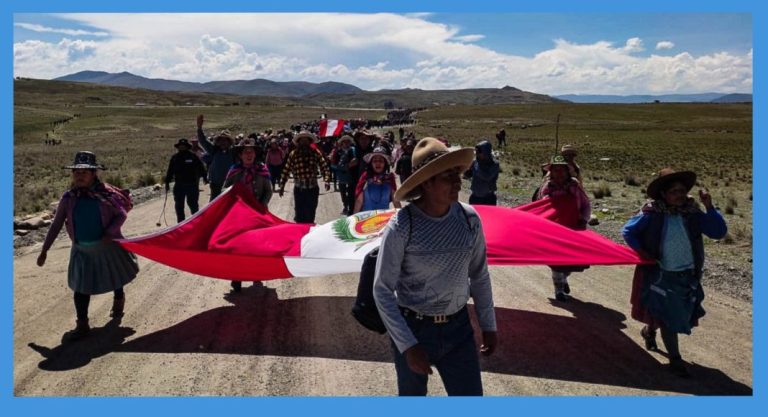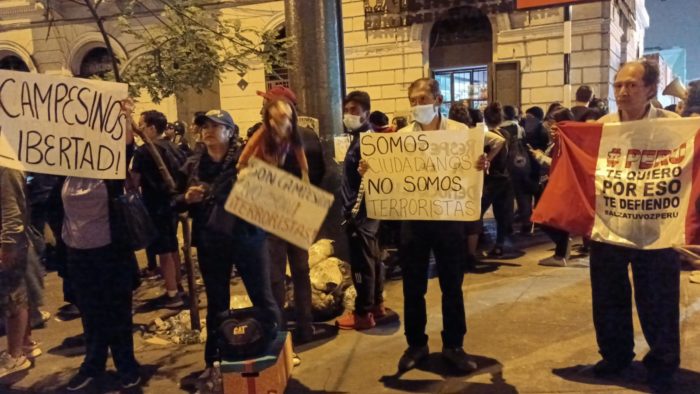
Accusations of human rights violations ripple through Peru
10 February, 2023‘¡Queremos Justicia!’ (‘We want justice’) chant a group of school children in Andahuaylas in a video circulating on social media. The cries are in response to the death of their 15 year-old classmate Daniel A.Q, who lost his life during a series of violent protests that began in Peru in December following the former President Castillo’s arrest for attempting to dissolve Congress.
These teenagers are not alone in their demands. Calls for justice can be heard across the mostly poor and rural communities that have been caught up in the social unrest and have experienced police repression, which has been denounced by many, including members of Congress.
On 19 December, the NY times posted heart-wrenching photos showing a convoy of funeral processions in Ayacucho, a city in Southern-central Peru, where hundreds of tearful and despairing faces appeared in a crowd described as ‘so dense it could float’. Throughout December, Ayucuho suffered the highest death toll. That was until 9 January, when a brutal collision between protesters and police in Juliaca, Puno left 16 dead and over 100 injured in just one day. The overall death toll now stands at 47 with over 600 injuries across the country.
Accusations of human rights violations
The causes of these deaths in Juliaca are yet to be confirmed, but testimonies suggest some police may have been using expanding bullets. These, as the name suggests, expand on impact to cause maximum damage, and have been banned for use in international conflicts since 1899. In December, it was also confirmed that 20 of the 22 deaths that took place that month were a result of a firearm fired by a member of the military or police, aiming directly at vital parts of the body such as the head, chest or abdomen.
The Ombudsman’s Office and Peruvian international human rights organizations have denounced the disproportionate use of force and the violation of the protesters’ human rights. Like Daniel A.Q, many of those who have been killed are young – minors, even – and were not necessarily participating in the demonstrations.
In response, the government has said they were seeking to defend the public and private infrastructure and restore the principle of authority. Acts of vandalism in several regional capital cities have meant public facilities such as the Judiciary, the Public Ministry, and SUNAT amongst others, have been set on fire and destroyed, along with attempts to take over airports in a few of the regions.
Many, however, feel Boularte was too quick to resort to force in response to the escalating protests. In her first few days in power she allied herself with her right-wing opposition in Congress and authorized the use of force to control citizen mobilization, first in Andahuaylas (Apurimac) and then in Ayacucho, Arequipa, Ica, Cusco, Puno, Junin, and other regions where protests were registered. Video testimonies suggest the use of undercover agents masked as civilians and violent groups in order to infiltrate and, as some videos seem to show, deliberately fuel further violence amongst the protesters.
Additionally, Boluarte’s decision to decree a State of Emergency lasting 30 days and the curfew in 15 provinces has also led to further arrests. In December, the authorities raided the Confederación de Campesinos del Perú, an historic national Indigenous organization, seizing machetes, ski masks, and other materials. Organizations such as Vía Campesina have denounced this persecution of Campesino leaders and suggested in some cases material is being planted to help accuse them of terrorism and criminal organization. Whilst these members have been released after intervention from lawyers and pressure from the public, other activists remain detained. And a law passed in Congress last month means they could be investigated for charges associated with organized crime.
A cry for social and economic justice for rural and Indigenous communities
These events have led many to question whether Boularte’s Presidency is tenable. The first female president in the republican life of Peru has already been forced to abandon hopes of remaining in power until 2026 and promised early elections in 2024, though this commitment has done little to quell protests. Instead, most are now calling for her immediate resignation in order to trigger elections this year.
What Boularte seems to have underestimated is the depth of the frustration in these regions. For many, the outcry is about more than the deaths of the community members, or indeed the reinstatement of Castillo. The justice these regions are demanding is social and economic justice and a commitment to more opportunities in rural regions after decades of neglect and a severe lack of development.
What Boularte seems to have underestimated is the depth of the frustration in these regions.

Less than a third of the country currently live below the national poverty line, compared with around half in the early 2000s. However, poverty in rural and Indigenous regions of Peru remains high, with around 8 million continuing to live in precarious conditions and an estimated 20 per cent of inhabitants of the Andean region living in extreme poverty.
Most rural parts of the Andes and Amazon are also severely lacking in access to basic services such as education, healthcare, and infrastructure in comparison to urban areas. According to the National Institute of Statistics in rural areas of Peru, only 83.1 percent of the population over the age of 15 is literate, compared to 91.5 percent for the country as a whole. There is also a lack of all-weather roads making it difficult to transport food to market and to access healthcare.
The role of mining in the social unrest
These issues have been aggravated by an intensification of extractive activity. Over the past 20 years, natural resource extraction in Peru has steadily increased, with gold production increasing by more than 50 percent between 2008 and 2018, and copper production by almost 30 per cent over the same period.
For many, the social unrest can be directly attributed to lack of transparency in these processes. These communities have long demanded a fundamental change in the extractive model which they argue mostly benefits large multinational organizations and can worsen the living conditions of many of those living in close proximity. The Ministry of Health recently indicated that more than 10 million Peruvians (nearly a third of the population) ingest heavy metals in the water they receive. The most affected areas are: Pasco, Puno, Amazonas, Callao, Made de Dios, Moquegua, Cusco, Ucayali, and Lambayeque. In Cajamarca it is estimated that 70 percent of water consumed by people has been previously used by the mining company Yanacocha Newmont. These worsening environmental conditions have also been exacerbated by a recent increase in informal or illegal mining due to the rise in mineral prices.
So, as Paul Maquet from Copper Acción has argued, to fully understand what is happening in Peru right now, it is important to remember that the mining areas in the southern Andes voted en masse for ‘no more poor in a rich country’. When a rural Indigenous teacher was elected as president, these areas felt a sense of hope that things might finally be about to change. In reality, Castillo did not stick to his promises of reforms, nor his promise to consider nationalizing the mining sector in order to benefit communities – amongst many other failed promises. In fact, by the end of his presidency, he was actively granting benefits to mining companies and promoting mining exploration.
But the fact of the matter remains that Castillo’s 18-month preventive detention for the alleged crime of rebellion, conspiracy, abuse of authority, and extensive disturbance of public peace has destroyed the hope these communities once had. It has served as a tipping point and released frustration that has been building for decades.
Main image: On 10 January, hundreds of people from Santo Tomás, Llusco, Quiñota, Colquemarca, Livitaca, and Chamaca mobillized, travelling to the Choccollo mining corridor to peacefully protest against President Boluarte, her ministers, and Congress. Photo: Derechos Humanos Sin Fronteras Cusco.
Red Muqui shine a light on police repression and the violation of human rights in the context of recent social unrest in Peru, and dig deeper into the tensions underpinning the protests and the violent state response. Red Muqui is a Peruvian network of 30 national and local institutions working on the development and protection of communities affected by mining and the metallurgy sector in Peru.
This article was kindly republished courtesy of Latin American Bureau. You can read the original here.
Follow Sounds and Colours: Facebook / Twitter / Instagram / Mixcloud / Soundcloud / Bandcamp
Subscribe to the Sounds and Colours Newsletter for regular updates, news and competitions bringing the best of Latin American culture direct to your Inbox.

